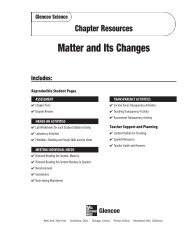chap06 - Learning Services Home
chap06 - Learning Services Home
chap06 - Learning Services Home
- No tags were found...
Create successful ePaper yourself
Turn your PDF publications into a flip-book with our unique Google optimized e-Paper software.
Molecule AMolecule BProductFigure 25 An enzyme makesa chemical reaction go fasterby bringing certain moleculestogether. Only the molecules thathave the right shape to fit on thesurface of the enzyme will react.Changing the Rate of Reaction Two ways tochange the rate of a chemical reaction are changingthe temperature and adding a type of compoundcalled a catalyst. For example, if you pour cake batterinto a pan and leave it on a table for severalhours, nothing seems to happen. However, if youput the pan in a hot oven, the cake batter becomes acake. Raising the temperature of the cake batter inthe hot oven causes substances in the batter to reactmore quickly.A catalyst (KA tuh list) is a substance thatchanges the rate of a chemical reaction without anypermanent change to its own structure. Many cellprocesses in your body are controlled by the presenceof catalysts, called enzymes, as shown in Figure 25.Enzymes are found throughout your body and areimportant for growth, respiration, and digestion.When you chew a piece of bread, glands in yourmouth produce saliva that contains an enzyme. Theenzyme in saliva acts as a catalyst to help break downstarches in food into smaller molecules.Many other chemical reactions depend on catalysts to helpEnzymemoleculethem go faster. The production of vegetable shortening, syntheticrubber, and high-octane gasoline are all chemicalprocesses that occur with the help of catalysts.SummaryChemical•ReactionsIn a chemical reaction compounds can be•broken apart and new compounds can form.Chemical energy is a form of potential energystored in the chemical bonds between atoms.•Energy in Chemical ReactionsEnergy must be supplied to start some chemicalreactions.•Reactions that absorb heat energy are•endothermic reactions.Reactions that release heat energy are•exothermic reactions.The rate of a reaction can be changed bychanging the temperature or using a catalyst.Self Check1. Explain how chemical energy is produced.2. Explain what happens to bonds when new compoundsare formed in a chemical reaction.3. Explain how a catalyst speeds up a reaction.4. Describe how photosynthesis transforms radiantenergy from sunlight into chemical energy.5. Think Critically Gasoline can react explosively withoxygen in air. Why doesn’t the gasoline in a car’s gastank explode when the gas cap is removed?6. Draw Conclusions Identify three processes that takeplace in your classroom that involve chemical reactions.Which of these reactions are exothermic?182 CHAPTER 6 Energyred.msscience.com/self_check_quiz














